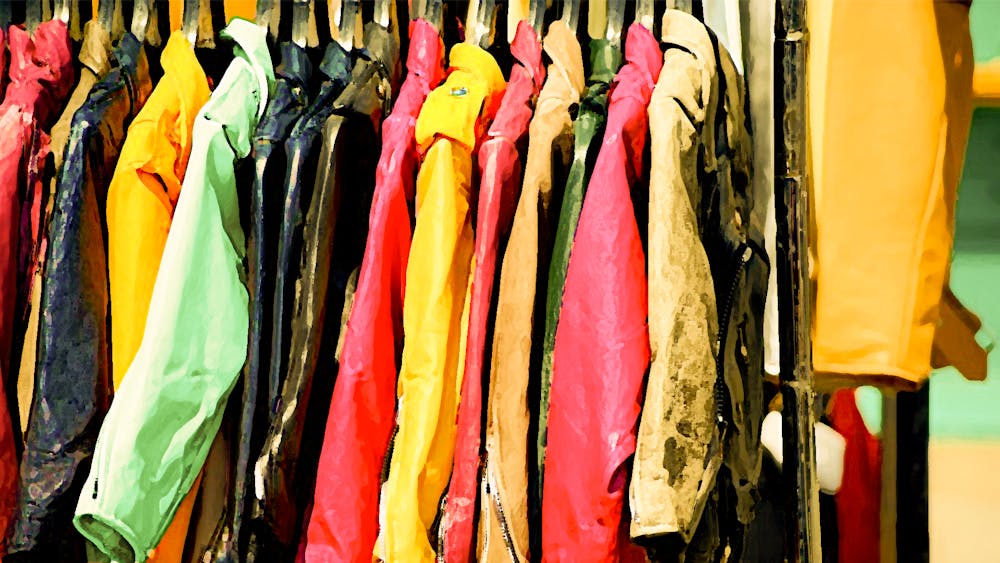Whenever someone walks in the room, you may first notice their sweater—a cerulean blue that goes perfect with their warm undertones. Maybe you like the sleek silhouette of their black suit but adore their olive socks they boldly paired with it. When the light hits their jacket, you notice a tiny chrysanthemum broach. You don’t know it, but they always wear it because of a book character with the same floral name.
Everything we put on tells a story. Sometimes the tales are less interesting than others—"I saw this trend on TikTok, so I bought what everyone else was wearing." If you’re interested in sharing who you are and your intentions at first glance, here is how to curate your color scheme, silhouettes, and accessories to do so.
Color Schemes
Picking a signature color scheme is a great way to not only form a signature look but to save yourself time and money. If the majority of your tops work with most of your skirts and pants, a few pieces can create weeks worth of looks. You may have heard of your “season” in reference to what tones look best on you. First named by cosmetologist Bernice Kentner, this color theory considers whether you are cool or warm toned—identifiable by whether your veins are visibly blue/purple or green. There are a plethora of quizzes one can take to find the colors that make them pop.
If you ever have trouble deciding whether sharp makeup looks are for you, or if you like sticking to softer palettes, you may benefit from a high–or–low contrast quiz. This test considers factors such as the difference between your skin and hair/eye color and how sharp your features are.
There is beauty in each type of look. Your face may be exquisitely chiseled or have soft edges like a Baroque painting, but trying to force a look that contradicts your features may leave you more frustrated than anything.
While your physical features are important in determining your color scheme, each color has a mysterious past. In her book The Secret Lives of Colors, Kassia St. Clair reveals the rebellious, romantic, and heroic ways colors can be utilized.
French socialite Daisy Fellowes was the embodiment of the scandalous 1920s. Known for her illicit affairs, shopping addiction, and hosting parties where only enemy pairings were invited, the only color that could match her insatiable style was named after her—shocking pink. It was a color later donned by Marilyn Monroe in her iconic pink gown from Gentlemen Prefer Blondes. A color that designer Elsa Schiaparelli described as “undiluted, pure,” and well … “shocking,” is a staple for when you refuse to be washed down.
Scarlet—the color is now most famously associated with the ostracized Hester Prynne of the novel by Nathaniel Hawthorne, The Scarlet Letter. Or more recently and arguably as significant, the dark red A that Emma Stone flaunted in 2010's Easy A. In February 1587, it represented Mary Queen of Scots' loyalty to the Catholic church. At her execution, she tore off her overclothes, revealing a bright red underdress.
In the modern day, red is associated with power. A simple red lip can be used as a way to take back power when told to blend in. For example, when Rep. Alexandria Ocasio-Cortez was told she wouldn’t be taken seriously with a bright look, she made a red lip her staple.
Silhouettes
Along with color, the first thing people notice of your look is the outline. Whether its padded shoulders or a poofy skirt, silhouettes guide the eye. This means that silhouettes can be cultivated to emphasize specific features.
In the 1920s, the ideal look for women was a “boyish” look. As women started to enter the workplace and have a more active role in society, they needed clothing that would allow them to move. The shift dress and drop waist became common in this era.
The key to the 20s look was a flat silhouette without any defined curves. But starting in the 1930s, the contrasting “power suit” gained traction. Marlene Dietrich was known as the first woman to popularize a "manly" suit in her 1930 film Morocco. As she struts into the nightclub, she uses the suit as a message to show that she belongs in a predominantly male scene. It was in the 1980s that a similar outline would reappear as the number of women entering the workforce increased. With shoulders broadened by shoulder pads and loose tailoring, it was the start of an increasingly androgynous fashion scene.
Silhouettes are closely related to gender identity as well. Traditionally, many women may try to tighten their waist and widen their hips and bust to create a feminine hourglass figure. On the other hand, men may utilize elongated shapes and vertical stripes to look taller or broad–shouldered jackets to look muscular.
However, fashion has increasingly been less focused on highlighting one's physical shape and more on the clothing itself. This shift leaves more room for individuals who may not conform to a specific gender or feel that gender norms shouldn't control this aspect of their lives. Randall Bachner, designer of the high end androgynous brand Marrakshi Life, references this change. “There is more global acceptance for individuals to express themselves without shame; a pride and confidence to be you in whatever you wear.”
No matter what you wear, conclusions can be drawn. It’s up to you to share a story that is unique and individual to yourself.







